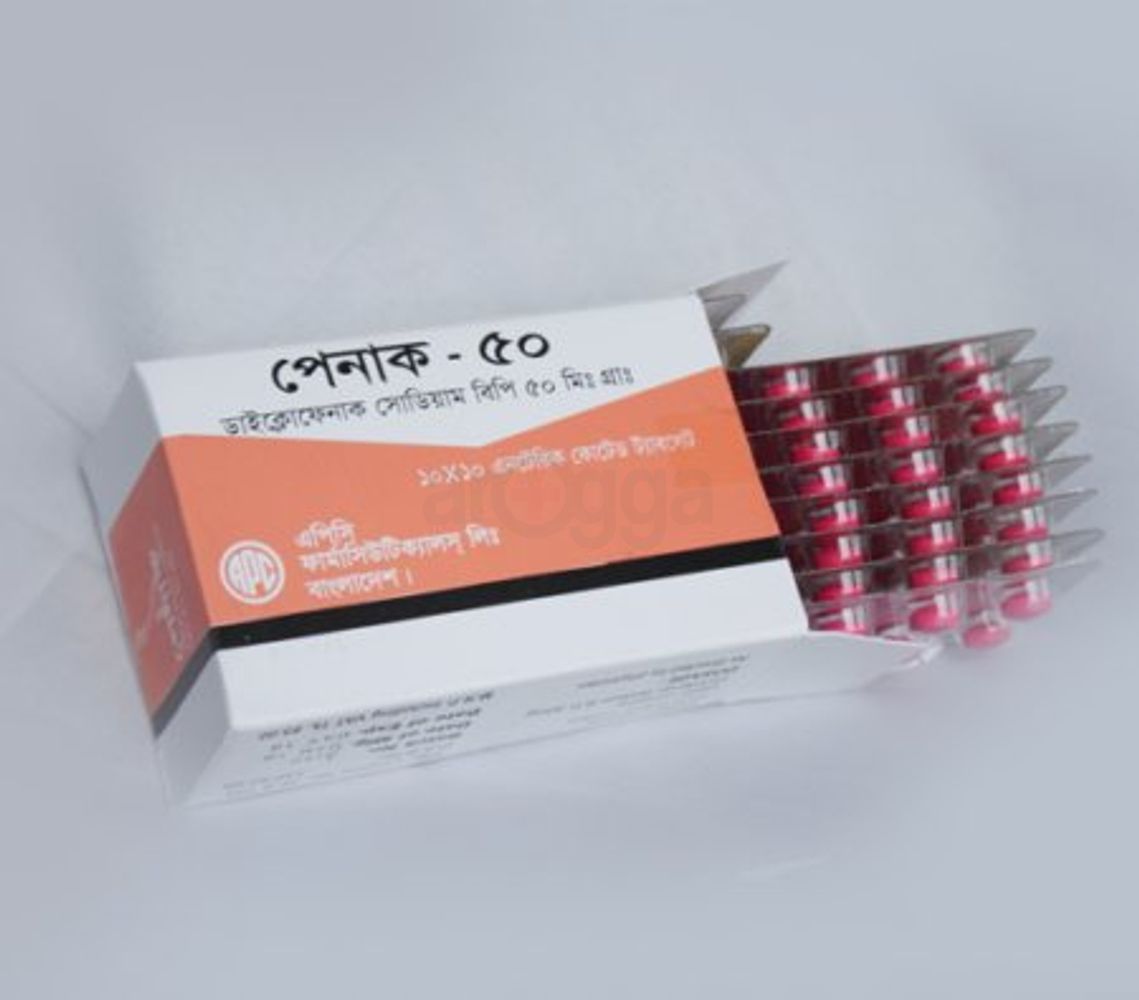

Out of stock
0
ব্যবসার জন্য পাইকারি দামে পণ্য কিনতে রেজিস্টেশন করুন
Register
APC Pharma Limited
Generic: Diclofenac Sodium
Out of Stock
Currently unavailable, please request or choose another variant.
৳ 0.78
৳ 0.85
8% OFF Medicine Overview of Penac 50mg Tablet
বাংলা
English
Indication
Rheumatoid arthritis, Osteoarthritis, Ankylosing spondylitis, Pain, Migraine, Dysmenorrhea, Muscle aches, Acute gout, Inflammation, Renal colic,Tendinitis, Backaches, Dental pain, Menstrual cramps, Bursitis
Administration
Should be taken with food. Take immediately after meals.
Adult Dose
Oral Rheumatoid Arthritis, Osteoarthritis Diclofenac sodium: 50 mg PO q8hr Extended release: 100 mg PO once daily; may be increased to 100 mg PO q12hr Ankylosing Spondylitis Diclofenac sodium: 25 mg PO 4 or 5 times daily Mild-to-Moderate Acute Pain, Dysmenorrhea 100 mg PO once, then 50 mg PO q8hr PRN Intravenous Postoperative pain Adult: As diclofenac Na: 75 mg infusion in glucose 5% or NaCl 0.9% (previously buffered w/ Na bicarbonate) given over 30-120 min or as bolus inj, may repeat after 4-6 hr if necessary. Max period: 2 days. Intramuscular Rheumatoid arthritis; Sprains ; Strains; Tendinitis; Pain and...
... Show moreContraindication
It is contra-indicated for those patients who are hypersensitive to Diclofenac. In patients with active or suspected peptic ulcer or gastrointestinal bleeding, or for those patients in whom attacks of asthma, urticaria or acute rhinitis are precipitated by aspirin or other NSAIDs possessing prostaglandin synthetase inhibitinig activity, it is also contraindicated.
Because of the presence of Lidocaine, it is also contraindicated for those patients who are hypersensitive to local anaesthetics of the amide type, although the incidence is very rare.
... Show moreMode of Action
Diclofenac, a phenylacetic acid derivative is a prototypical NSAID. It has potent anti-inflammatory, analgesic and antipyretic actions. It reversibly inhibits the enzyme, cyclooxygenase, thus resulting in reduced synthesis of prostaglandin precursors.
Precaution
History of gastrointestinal ulceration, haematemesis or melaena, ulcerative colitis, Asthma or history of asthma, Crohn's disease, bleeding diathesis or haematological abnormalities. Patients with severe hepatic, cardiac or renal insufficiency or the elderly people, Current or previous high blood pressure ( hypertension) should be kept under close surveillance. All patients who are receiving long-term treatment with NSAID agents should be monitored as a precautionary measure (e.g., renal, hepatic function and blood counts).If abnormal liver function tests persist or worsen, clinical signs and symptoms consistent with liver disease develop or if other manifestations occur, Diclofenac sodium should be discontinued. Use of Diclofenac...
... Show moreSide Effect
Side-effects of Diclofenac is usually mild and transient. It is generally well tolerated. At the starting of the treatment, however, patients may sometimes complain of gastrointestinal discomfort, epigastria pain, eructation, nausea and Diarrhoea, headache and bleeding sometime may occur. Occasionally skin rash, peripheral oedema and abnormalities of serum transaminase have been reported.Very rarely reported side effects include activation of peptic ulcer, haematemesis or melena, blood dyscrasia (extensive usage). There have been isolated reports of anaphylactoid reactions.
... Show morePregnancy Category Note
Pregnancy Published literature reports that use of NSAIDs after 30 weeks’ gestation increases risk of premature closure of fetal ductus arteriosus; data from observational studies regarding potential embryofetal risks of NSAID use, including diclofenac, in women in first or second trimester of pregnancy are inconclusive; avoid use of NSAIDs in pregnant women starting at 30 weeks of gestation (third trimester) Infertility Based on mechanism of action, the use of prostaglandin-mediated NSAIDs, may delay or prevent rupture of ovarian follicles, which has been associated with reversible infertility in some women; published animal studies have shown that administration of prostaglandin synthesis inhibitors...
... Show moreInteraction
May increase serum levels of methotrexate. Concomitant use w/ other NSAIDs or anticoagulants (e.g. warfarin) is associated w/ higher risk of GI bleeding. Increased risk of nephrotoxicity w/ ciclosporin or triamterene. May increase the risk of developing corneal complications in patients w/ significant pre-existing corneal inflammation when use concomitantly w/ ophth preparation containing corticosteroids. Colestyramine and colestipol reduce the bioavailability of diclofenac. Decreased plasma concentration when administered after sucralfate. Ophth application of diclofenac may reduce the efficacy of ophth acetylcholine and carbachol. May increase serum levels of lithium and digoxin.
ব্যবসার জন্য পাইকারি দামে পণ্য কিনতে রেজিস্টেশন করুন
Register
APC Pharma Limited
Generic: Diclofenac Sodium
Out of Stock
Currently unavailable, please request or choose another variant.
৳ 0.78
৳ 0.85
8% OFF Alternative Brands For Penac
Sort by:
Relevance
Disclaimer
The information provided herein is accurate, updated and complete as per the best practices of the Company. Please note that this information should not be treated as a replacement for physical medical consultation or advice. We do not guarantee the accuracy and the completeness of the information so provided. The absence of any information and/or warning to any drug shall not be considered and assumed as an implied assurance of the Company. We do not take any responsibility for the consequences arising out of the aforementioned information and strongly recommend you for a physical consultation in case of any queries or doubts.